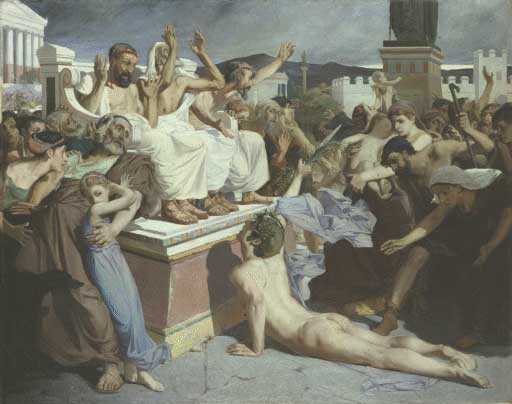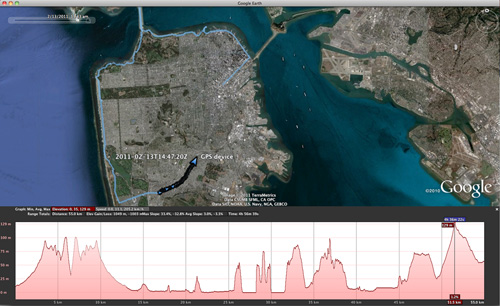
If you’ve decided to take “fitness” somewhat seriously, it is important to have goals. They don’t have to be big goals! “Work out every other day” is actually a perfectly reasonable, manageable goal and encourages framing your health as a process, not an achievement. It is not, however, very dramatic. And goodness knows, a lot of people are highly motivated by fucking drama. I know I am!
Many people casting about for a heroic challenge decide to run a marathon. I mean, the event format was pretty much invented from whole cloth for the 1896 Olympics as a marketing stunt. There is nothing in physics or biology that really makes 26.2 miles a significant distance. It is, quite literally, an arbitrary goal selected primarily for its theatricality and the frisson of possible tragedy. Sure, maybe some ancient Greek dude named Pheidippides (or Phillipides) ran from Marathon to Athens (or, even more heroically, from Athens to Sparta and then back) to deliver the news of a victory over the Persians. The effort might have also killed him! Which I think is your your cue to emit a gasp and faint onto the furniture you purchased especially for the occasion.
The good news is that the chances you’ll die from attempting a marathon are vanishingly small today, especially if you prepare for it thoroughly and aren’t on a diet of Spartan black broth. People around the world, of all ages and genders, shapes and sizes, finish a marathon or three every year. Any reasonably healthy person who can walk a couple of miles without difficulty can probably do it. And if you can’t walk? Wheelchairs are actually faster!
The Script
The first thing you’ll need if you want to complete a marathon is a plan. I’ve started training for my second California International Marathon on December 2nd, and am going to attempt to qualify for Boston Marathon, the oldest of the annual races. I’m on the third week of a twelve week training campaign, and am a relatively experienced athlete who is trying to go faster. If you’re new to distance running, you’ll want to find a race at least three months out, preferably four or more especially if you’re new to running entirely. Running in the USA has a searchable database of races, including upcoming marathons in California.
I would like to take a moment to point out that while running has been transformative for me, my fitness journey didn’t start with it. Two years and four stone ago I decided that if I was going to exercise with the goal of losing weight, I was going to stick with non-impact aerobic exercise primarily. Basically? Cycling. While I probably could have jogged safely, at the time I couldn’t run without difficulty and significant discomfort, and I worried about and injury derailing any enthusiasm or commitment I might manage to maintain.
The fact is, your muscles can fix themselves, and will, but your joints and ligaments can’t for the most part. So the less weight you carry absolutely, and the higher the ratio of muscle to fat relatively, will all mean less impact and tension stress on those joints and ligaments. I spent months on stationary bikes and lost dozens of pounds before joining a friend on the treadmill doing a Couch to 5K progressive walking and running program. As I got progressively leaner, I went progressively farther and faster. I focused on triathlon for the cross-training and I didn’t run my first marathon race for over a year.
Which is also to say that you really should talk to a doctor before starting out on a marathon campaign, at least if you aren’t talking to a doctor once or twice a year already. A good coach or mentor is better yet, and a team better still. I worked with Duane Franks from Trifiniti and a team of colleagues at Joyent. If you’re on a budget, I’d recommend at least getting some friends together or joining one of the local running clubs. I mean, I guess I could have done it, maybe, without any of the above. But it would have been much more difficult and risky.
Rehearsals
The other thing you’re going to need is time. A typical beginner regimen (from 15 to 40 miles a week) run at a typical beginner pace (12:00 minutes per mile) is going to involve anywhere from three to twelve hours of running in any given week. Add to that time to travel, shower, change, stretch, cross train, and on your peak week it will feel like a part time job on the side requiring up to twenty hours. The good news is that, at least until a point, I’ve found that the running and training in general ends up productivity-neutral. For every hour you spend, you get an hour of extra energy and attention out of the day, and there are ways to mitigate the impact on your schedule through efficiencies like scheduling a run before your morning shower to cut down on costume change time.
For the actual running schedule, I’m currently using a cookie cutter training cycle from Running Times to schedule my workouts titled “Run Your Best Marathon. Really,” which is proving pretty intense! There’s a range of options at Runner’s World as well, among many other publishers that can be found online. I use Google Calendar to then set workout reminders with email and SMS alerts, but obviously any reminder system will do as long as you actually use it.
The basic idea of most training programs is built around the “periodization cycle,” and if you find one that seems reasonable you’ve pretty much found them all. You stress your muscles during intense exercise and your body heals you up better, faster and stronger while you recover between workouts. You gradually increase stress, both within a week by varying intensity and distances and over the months by increasing your maximum run distances, taking care to observe rest days. Ultimately, you’ll be running nearly marathon distances before the last couple of weeks ahead of the race, and then you’ll taper off in order to arrive at the starting line at the peak of the cycle.
Finding a friend or three to sign up for a race with you gives you an opportunity to train with someone on the same cycle. While I personally crave the loneliness of the long distance, I did run with the Golden Gate Running Club, the San Francisco Road Runners, the Dolphin South End Runners and the San Francisco Front Runners. All of them have regularly scheduled runs throughout the week, and feature attractively motley crews of people from a range of backgrounds at at a range of skill level so you can surely find somewhere to fit in and someone with experience to share. Many of the club members I talked to said that the focus was more social than anything else. In other words, perfect for extroverts. Dues were nominal, starting as low as $40 a year.
Props and Costume
Finally, you’re going to need some gear. The good news is that relative to some other pursuits, running is relatively cheap. I mean, you can spend a lot of money very quickly and I certainly have! But you don’t have to.
The most important item is obviously shoes. My first running shoes? I got them at Ross. Until I had some more money in my pocket and saw a pair of Merrell Trail Gloves and fell in love with their rugged minimalism. But you don’t have to go in for the current faddish footwear. I love the folks at Sports Basement, where you can find public demos and discussions of your options taking into account your stride and footfall form. That pair of old hooves is about to be retired in favor of a pair of Merrell Barefoot Run Bare Access which offer a bit more compromise in the cushioning department for running long stretches of road.
You’ll also want lots of clothes. Because if you’re going to be running anywhere from three to six times a week, you don’t want dirty laundry getting in the way of the routine. And like anything in San Francisco, you’re going to want to layer! Tee shirts and a light, wool sweater or polyfleece if necessary are generally fine. You’ll want clean tops, bottoms and socks for each day you plan to run between loads of laundry. A hat might be nice on sunny days, and sunglasses. All of which can be had at your favorite thrift store or discounter.
[Ed note: Jackson can’t speak to this, so I will: as a 32DD woman who’s been running distance for almost 20 years, I cannot overstate the importance of a good sports bra. If you’re more than a B cup, those little shelfy things are not going to do. I strongly recommend a visit to See Jane Run to get fitted with something that gets your breasts as close to Boys Don’t Cry as possible. When I went from a Mervyn’s shelf sports bra to a Moving Comfort it made an incredible amount of difference in comfort and performance not just on the road but in the gym. Suck it up and spend the $50-60 bucks, and wash the bra at home in the sink. Don’t put it in the drier! — EB]
Your nipples will be rubbed raw by your American Apparel tee five miles in, and your thighs will chafe in your short shorts by mile ten, so besides sunscreen you will definitely want to pick up some Body Glide or similar personal lubricant while you’re at Sports Basement. You do not, strictly, need a FuelBelt or a CamelBak or any other specialized gear for long runs, but if they make things more fun or comfortable, by all means.
I swear by having some sort of GPS tracking, either a dedicated device like my Garmin ForeRunner 310XT or a smartphone app, partly because the metrics provide motivation and feedback I can use, in part to generate maps like the one above. But I also use Training Peaks Run Tracker for the iPhone, but there are plenty of free options out there, such as MapMyRUN or RunKeeper. I also use TrainingPeaks to upload my Garmin data and track my training over time. Strava is another popular way to post workouts and find routes. In the absence of a tracking device, I used the Google Maps Distance Calculator to plan or estimate routes.
So there you go: Where to find a script, fellow actors and snazzy costumes, which is really all you need to get started on your dramatic journey. In the next act, we’ll get into more detail how to keep the action interesting during the tests and ordeals — through novel routes, varying workouts, cross training, good music and better metrics — before discussing race preparation for the road home to victory and glowing reviews. Until then, break a leg!
This is the first installment in a Smokin’ Fast series on marathon training. Continue on to part the second, Improve Your Marathon Performance By Taking Regular Rehearsals And Ruthless Reviews In Stride and part the third, Marathon Finishers Keep Calm and Carry On!
Jackson West has previously written about cycling in San Francisco for the Appeal. Have a question or suggestion or just a story to share? Send it in! For more indulgent, self-involved health and wellness coverage visit Fitness Douchebags.
Want more news, sent to your inbox every day? Then how about subscribing to our email newsletter? Here’s why we think you should. Come on, give it a try.










